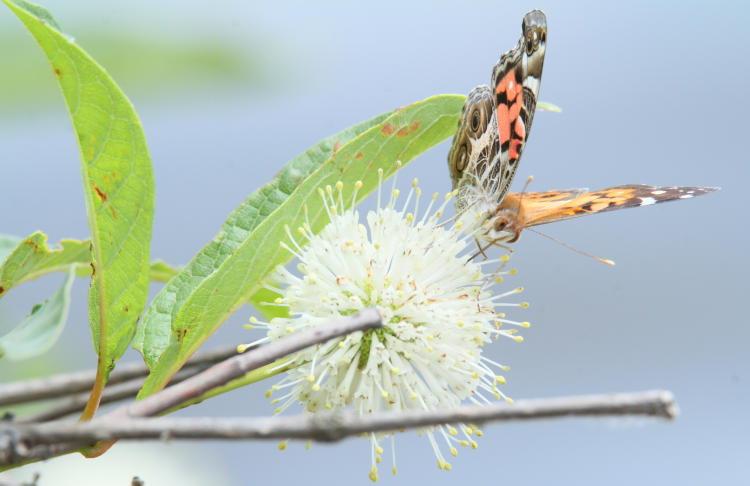On an outing the other day, I captured very little of interest, but I can throw down a couple of frames anyway. I initially went back down to Jordan Lake in an attempt to repeat my luck of a couple weeks ago, but that failed miserably. So while poking around, I snagged a few images of vague appeal. Boy, just selling the excitement, aren’t I?

This was not at all the way to go about it, but I was too lazy to change lenses, plus the fact that in the time it would have taken, the butterfly might have left, plus the fact that I still wanted to be ready for osprey and eagles, so this was shot with the Tamron 150-600 lens – I can’t complain. This is a painted lady butterfly (Vanessa cardui) feeding from the recognizable blossoms of a buttonbush (Cephalanthus occidentalis.) I shouldn’t tell you this, but I trust you: the synchronicity of the butterfly’s wings and the leaves of the bush wasn’t actually noticed at the time, though I cropped the frame to emphasize this here. But how well does the long lens perform as a macro? Let’s go in closer on that same frame and see.

That’s not too shabby, that is – or isn’t; what’s the proper word there? Either way, I’m not going to make a habit of this, mostly because I have two good-performing macro lenses already that aren’t one quarter as unwieldy as the long Tamron, but it’s nice to know that its close-focus ability is more than acceptable.
Eventually I left there to check on two different osprey nests to see if there was evidence of the young having hatched, but on the way out I heard some nearby ‘muttering’ that I recognized, and immediately spotted this guy taking a perch in a narrow opening in the branches.

I’m hesitant to switch away from the long lens too quickly, because that habit has stood me well before, and again here. This red-bellied woodpecker (Melanerpes carolinus) might well have been a juvenile, and I say that partially because its proportions didn’t seem quite like an adult, and partially because it was cackling softly with another in the immediate vicinity, who I caught only the barest glimpse of; I’ve had experience multiple times of woodpecker siblings hanging around together and gossiping softly. This one, at least, shows its namesake pinkish belly, one of the least visible traits for a species to be named after, but not as bad as double-crested cormorants.
Neither osprey nest showed signs that the young had hatched, though both appeared to be occupied, so I’m still biding my time. But while walking back from the second, I was passing a small field of wildflowers and shot another few frames of opportunity.

I did a brief search for both of these species, but there are too many variations of each, and too few details to pin anything down, within my sources at least. The flowers, almost certainly of the aster family, were no more than 15mm across, making the bug quite small in itself, but I can at least identify it as a True Bug (Hemiptera) because of the wings and proboscis. This was taken with one of those dedicated macro lenses, the Mamiya 80mm, but in difficult conditions, since the flowers were quite tall, over a meter, and thus swayed in the slightest breeze. Between that, and my attempts to hold still at the precise distance of sharp focus, it was largely hit-or-miss, trying to fire off frames as everything came together. Most of what I shot will be discarded, but this one is close enough, as a tighter crop shows:

Those are some fine markings there, continuing even onto the legs, though not helping it blend in with the aster at all. But you can imagine trying to succinctly (yet effectively) describe it in a search engine to determine the species; not worth any more time than I’ve already spent. I feel quite comfortable that your lack of certainty regarding the species will not be debilitating.



















































